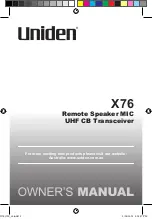
TM8100/TM8200 Computer-Controlled Data Interface (CCDI) Protocol Manual
CCDI
35
© Tait Electronics Limited
April 2007
1.9.7
SEND_SDM
The SEND_SDM command tells the radio to send a Short Data Message
(SDM) but the
is normally used instead.
An SDM can be received when the radio is in Command mode.
Format
s [SIZE] [LEAD_IN_DELAY] [DATA_MESSAGE_ID]
[MESSAGE] [CHECKSUM]
After an SDM is sent, if the ‘SDM Auto Acknowledge’ field is set in the
programming application, the radio waits for an acknowledgement before it
generates a PROGRESS message. The PROGRESS message is either type
1D0 ‘SDM auto-acknowledge not received’ or 1D1 ‘SDM auto-
acknowledge received’. Refer to
Note that the delay before the acknowledgement is sent and how long the
radio waits is also set in the programming application.
In Command mode, when any SDM is received, whether valid or not, the
radio sends an ‘FFSK Data Received’ PROGRESS message to the PC.
If the SDM is valid with a [MESSAGE] component, the radio also sends an
‘SDM Call’ RING message to the PC. If no [MESSAGE] component is
received, RING will be type ‘Data Call’.
The radio can be programmed to issue an audible indicator when a valid
SDM is received while in Command mode.
Note
The radio can not receive any further SDMs if one is already
stored in the buffer. The buffer must be cleared using a CANCEL
command.
■
‘s’ is sent as a single ASCII character and represents the SEND_SDM
command.
■
[LEAD_IN_DELAY] is two ASCII hex characters representing the delay
after the radio transmitter keys-up and the start of data transmission,
while the radio is in Command mode.
The range is 00 to FFh. The actual delay is calculated by multiplying the
number by 20ms. This corresponds to a Lead-In Delay between 00ms
and 5.1s, in steps of 20ms. A minimum of at least 20ms of Lead-In Delay
is required for the radio.
■
[DATA_MESSAGE_ID] is an 8-character string representing the SDM
data identity of the radio to which the SDM is being sent. It can be any
alphanumeric characters. “
*
” is the wildcard for any character, e.g.
12
**
5678. The first four bytes are generally the fleet identity, the second
four the radio identity.
When a radio receives a SDM message, the data identity is checked
against the ‘Unit Data Identity’ set in the Data form of the programming
application. Refer to
. If the data identity
matches, the received SDM data is stored and the radio sends a response.
If the data identity does not match then the SDM data is ignored.
















































